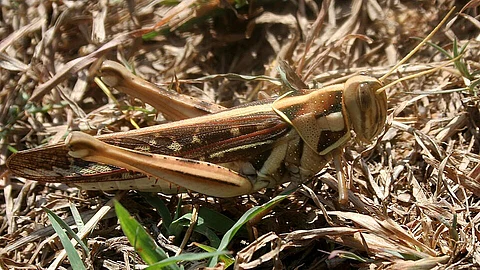
- Topics
- Feature
- Opportunities & Events
- About
- Hindi Portal
- Data
- Topics
- Feature
- Opportunities & Events
- About
- Hindi Portal
- Data

When the skies darken—not with rain, but with insects—farmers brace for impact. The desert locust, one of the world’s most destructive pests, can travel in swarms the size of cities, devouring everything green in its path. For generations, these insects have been feared across Africa, the Middle East, and South Asia—including India—where they threaten food security and livelihoods. But with the help of technology, we may finally be able to detect, track, and control these destructive invaders before it's too late.
Why are desert locusts so dangerous?
Desert locusts, (one of nine known species, three of which are found in India) are grasshopper-like insects that thrive in wet, post-rain conditions. Moist soil and fresh vegetation allow them to breed rapidly. Under the right conditions, they switch from a solitary lifestyle to a gregarious phase—gathering in massive swarms, changing colour and shape, and even growing larger brains. In this phase, their endurance increases. They can stay airborne for up to 10 hours a day, travelling over 100 km daily. A single swarm can strip entire farmlands bare—eating wheat, maize, legumes, and vegetables and leaving devastation in its wake.
India's locust crisis: A snap shot
The 2019–2020 desert locust outbreak was one of the worst India has seen in decades. Rajasthan, Gujarat, Maharashtra, Madhya Pradesh, and Uttar Pradesh were hit the hardest. An estimated 48,668 km² of cropland—about 4.6 percent of India’s total farmland—was damaged.
Maharashtra suffered the most, with over 10 percent loss, followed by Madhya Pradesh (4.4–6.7 percent) and Uttar Pradesh (3.5–5.2 percent). Gujarat and Rajasthan saw crop damage of up to 4,922 km² combined. The estimated economic loss was a whopping US $3 billion, or 13 percent of India’s agricultural budget that year. The swarms also triggered massive food shortages, market volatility, and rising prices—hitting farmers and low-income families the hardest.
Climate change: Fuel to the fire
Scientists warn that climate change is making locust attacks more frequent and unpredictable. Rising temperatures, erratic rainfall, and extreme weather events such as cyclones and floods are creating ideal conditions for locust breeding and migration. Urbanisation, deforestation, and expanding agriculture are also altering their natural routes and habitats.
Satellite readings have shown sharp drops in crop yield (up to 500 kg/ha) and vegetation health during swarm attacks, reducing carbon absorption and indirectly contributing to CO₂ buildup. By 2100, global warming may expand locust-friendly zones in western India and West Central Asia by 5–25 percent.
Can technology offer early warnings?
India and other affected countries follow a preventive approach to locust control—spraying insecticides and monitoring outbreaks. But by the time a swarm is spotted, it may be too late. New research offers hope by using technology for early detection.
A recent study titled ‘Doppler weather radars as a game changer in desert locust swarm tracking’ published in Nature Scientific Reports by N. A. Anjita and colleagues, explores how Doppler weather radars (DWRs) can be used to monitor swarms in real time. Traditionally, tracking locusts involved observing vegetation patterns, rainfall, and soil moisture using satellite data. UAV based technologies have also been deployed to locate locust eggs and nymph bands. Now, scientists are also exploring the use of Doppler Weather Radars (DWRs) to study migratory birds and insects with more precision for locating them and monitoring them during their flight.
While it is important to understand locust movements at large spatial and temporal scales in India, very few studies are available in India due to lack of adequate data. This study leveraged India’s existing DWR network to monitor locust warm behaviour across agrarian regions. By combining high-resolution meteorological and ecological data, the research tried to overcome traditional challenges in direct monitoring.
The study found that:
Locust swarms initiated flight 2–3 hours after sunrise, stayed airborne for 9–10 hours, and settled near sunset. They paused mid-flight during extreme heat and followed downwind paths—unless influenced by food availability.
The swarms did not take off if wind speeds exceeded 6–7 m/s. Despite individual locusts within a swarm orienting themselves differently, the overall movement was predominantly downwind. Swarms usually travelled at slightly lower speeds than wind speed and could cover distances exceeding 100 km daily.
Locusts did not only follow the wind trajectory, but also depended on factors such as food availability. For example, in areas like Lucknow, swarms altered their direction towards higher crop density, deviating from wind trajectories. In contrast, swarms near New Delhi followed wind patterns more closely indicating that other factors may also influence flight behaviour.
Land Use Land Cover (LULC) and Normalised Difference Vegetation Index (NDVI) analysis showed that crop availability significantly influenced swarm movement. For instance, crop area around New Delhi comprised 34.97 percent, and in Lucknow, 29.11 percent. Swarms moved from low vegetation density zones to more fertile croplands, confirming that food availability—not just wind—shaped their flight patterns.
DWRs lead in terms of efficiency and coverage for early warnings
The study found that the Doppler Weather Radar (DWR) proved to be very efficient with a potential to establish early warning systems with lead times of 5–7 h and a spatial coverage of approximately 100 km, aiding timely mitigation efforts.
While satellite imagery is found to be constrained by resolution limitations that impede swarm detection, DWRs offer unparalleled spatial and temporal resolution, making them indispensable tools to establish early warning systems for locust detection, argues the study.
Both single and dual-polarised DWRs, have the ability and can be used to detect swarms by tracking them effectively and have been found to be very cost-effective as early warning systems for desert locusts. The study highlights the need for utilising the the untapped potential of existing weather radar network infrastructures for ecological monitoring of insects such as locusts in the future.